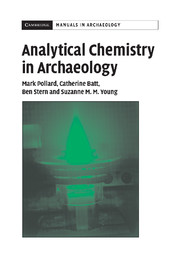Book contents
- Frontmatter
- Contents
- List of figures
- List of tables
- Preface
- PART I THE ROLE OF ANALYTICAL CHEMISTRY IN ARCHAEOLOGY
- PART II THE APPLICATION OF ANALYTICAL CHEMISTRY TO ARCHAEOLOGY
- 3 ELEMENTAL ANALYSIS BY ABSORPTION AND EMISSION SPECTROSCOPIES IN THE VISIBLE AND ULTRAVIOLET
- 4 MOLECULAR ANALYSIS BY ABSORPTION AND RAMAN SPECTROSCOPY
- 5 X-RAY TECHNIQUES AND ELECTRON BEAM MICROANALYSIS
- 6 NEUTRON ACTIVATION ANALYSIS
- 7 CHROMATOGRAPHY
- 8 MASS SPECTROMETRY
- 9 INDUCTIVELY COUPLED PLASMA–MASS SPECTROMETRY (ICP–MS)
- PART III SOME BASIC CHEMISTRY FOR ARCHAEOLOGISTS
- Epilogue
- Appendices
- References
- Index
3 - ELEMENTAL ANALYSIS BY ABSORPTION AND EMISSION SPECTROSCOPIES IN THE VISIBLE AND ULTRAVIOLET
Published online by Cambridge University Press: 03 May 2010
- Frontmatter
- Contents
- List of figures
- List of tables
- Preface
- PART I THE ROLE OF ANALYTICAL CHEMISTRY IN ARCHAEOLOGY
- PART II THE APPLICATION OF ANALYTICAL CHEMISTRY TO ARCHAEOLOGY
- 3 ELEMENTAL ANALYSIS BY ABSORPTION AND EMISSION SPECTROSCOPIES IN THE VISIBLE AND ULTRAVIOLET
- 4 MOLECULAR ANALYSIS BY ABSORPTION AND RAMAN SPECTROSCOPY
- 5 X-RAY TECHNIQUES AND ELECTRON BEAM MICROANALYSIS
- 6 NEUTRON ACTIVATION ANALYSIS
- 7 CHROMATOGRAPHY
- 8 MASS SPECTROMETRY
- 9 INDUCTIVELY COUPLED PLASMA–MASS SPECTROMETRY (ICP–MS)
- PART III SOME BASIC CHEMISTRY FOR ARCHAEOLOGISTS
- Epilogue
- Appendices
- References
- Index
Summary
This chapter reviews some of the most common techniques used to analyze a wide range of inorganic materials. The techniques are all based on the emission or absorption of radiation in the visible or ultraviolet region of the electromagnetic spectrum. The full background to these techniques is set out in Chapter 12, as are the principles underlying the quantification of the methods (the Beer–Lambert law). The first technique described (OES) is now obsolete, and in archaeology was replaced in the 1980s by atomic absorption. This, in turn, has been largely superseded by another emission technique, but this time using an inductively coupled plasma (ICP) torch to achieve a higher temperature. This chapter explains the use of ICP excitation as a source for emission spectroscopy (ICP–AES, sometimes termed ICP–OES). A discussion of the use of ICP excitation as an ion source for mass spectroscopy (ICP–MS) is deferred to Chapter 9, following a general discussion of mass spectrometry (Chapter 8). Section 13.4 gives an overview of the comparative performance of this family of techniques, in terms of minimum detectable levels (defined in full in Section 13.4) across the periodic table. More detailed information on atomic absorption spectroscopy (AAS) can be found in Price (1972), Varma (1985), Haswell (1991), and on ICP–AES in Golightly and Montaser (1992), Boss and Fredeen (1999), Nölte (2003), and Thompson and Walsh (2003).
- Type
- Chapter
- Information
- Analytical Chemistry in Archaeology , pp. 47 - 69Publisher: Cambridge University PressPrint publication year: 2007
- 1
- Cited by

